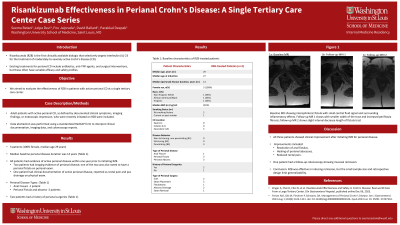Monday Poster Session
Category: IBD
P2702 - Risankizumab Effectiveness in Perianal Crohn’s Disease: A Single Tertiary Care Center Case Series
Monday, October 28, 2024
10:30 AM - 4:00 PM ET
Location: Exhibit Hall E

Has Audio

Seema Belani, MD
Washington University School of Medicine in St. Louis / Barnes-Jewish Hospital
St. Louis, MO
Presenting Author(s)
Award: Presidential Poster Award
Seema Belani, MD1, Jalpa Devi, MD2, Fnu Jaiprada, MD2, David Ballard, MD2, Parakkal Deepak, MBBS, MS3
1Washington University School of Medicine in St. Louis / Barnes-Jewish Hospital, St. Louis, MO; 2Washington University School of Medicine in St. Louis, St. Louis, MO; 3Washington University in St. Louis, St. Louis, MO
Introduction: Risankizumab (RZB) is the first clinically available biologic that selectively targets interleukin (IL)-23 for the treatment of moderately-to-severely active Crohn’s disease (CD).
Existing treatments for perianal CD include antibiotics, anti-TNF agents, and surgical interventions, but these often have variable efficacy and safety profiles. We aimed to evaluate the effectiveness of RZB in patients with active perianal CD at a single tertiary care center.
Case Description/Methods: Adult patients with active perianal CD, as defined by documented clinical symptoms (such as rectal pain and pus drainage), imaging findings (such as fistulas or abscesses) or endoscopic impression (noting perianal disease), who recently initiated on RZB were included. Data abstraction was performed using a standardized RedCAP form to interpret clinical documentation, imaging data, and colonoscopy reports.
Discussion: Three female patients with a median age of 29 years were included in this case series. The median baseline perianal disease duration was 14 years and median age at induction was 27 years. All three patients had active perianal disease prior to initiating RZB. Two patients had imaging evidence of perianal disease within the year prior to initiating RZB, one of which also had colonoscopy with perianal fistula noted on perianal exam. One of the three patients had clinical documentation of active perianal disease that was reported as rectal pain with pus drainage. All three patients had documented clinical improvement of perianal disease following initiation of RZB, noted as improvement in previously demonstrated anal fistula, healing of perianal abscess, or improvement in rectal pain. One of these patients also had follow-up colonoscopy demonstrating mucosal remission.
RZB appeared effective at inducing clinical remission in a small sample size of patients with active perianal disease. However, the small sample size and retrospective design limit the generalizability of these findings.
Note: The table for this abstract can be viewed in the ePoster Gallery section of the ACG 2024 ePoster Site or in The American Journal of Gastroenterology's abstract supplement issue, both of which will be available starting October 27, 2024.
Disclosures:
Seema Belani, MD1, Jalpa Devi, MD2, Fnu Jaiprada, MD2, David Ballard, MD2, Parakkal Deepak, MBBS, MS3. P2702 - Risankizumab Effectiveness in Perianal Crohn’s Disease: A Single Tertiary Care Center Case Series, ACG 2024 Annual Scientific Meeting Abstracts. Philadelphia, PA: American College of Gastroenterology.
Seema Belani, MD1, Jalpa Devi, MD2, Fnu Jaiprada, MD2, David Ballard, MD2, Parakkal Deepak, MBBS, MS3
1Washington University School of Medicine in St. Louis / Barnes-Jewish Hospital, St. Louis, MO; 2Washington University School of Medicine in St. Louis, St. Louis, MO; 3Washington University in St. Louis, St. Louis, MO
Introduction: Risankizumab (RZB) is the first clinically available biologic that selectively targets interleukin (IL)-23 for the treatment of moderately-to-severely active Crohn’s disease (CD).
Existing treatments for perianal CD include antibiotics, anti-TNF agents, and surgical interventions, but these often have variable efficacy and safety profiles. We aimed to evaluate the effectiveness of RZB in patients with active perianal CD at a single tertiary care center.
Case Description/Methods: Adult patients with active perianal CD, as defined by documented clinical symptoms (such as rectal pain and pus drainage), imaging findings (such as fistulas or abscesses) or endoscopic impression (noting perianal disease), who recently initiated on RZB were included. Data abstraction was performed using a standardized RedCAP form to interpret clinical documentation, imaging data, and colonoscopy reports.
Discussion: Three female patients with a median age of 29 years were included in this case series. The median baseline perianal disease duration was 14 years and median age at induction was 27 years. All three patients had active perianal disease prior to initiating RZB. Two patients had imaging evidence of perianal disease within the year prior to initiating RZB, one of which also had colonoscopy with perianal fistula noted on perianal exam. One of the three patients had clinical documentation of active perianal disease that was reported as rectal pain with pus drainage. All three patients had documented clinical improvement of perianal disease following initiation of RZB, noted as improvement in previously demonstrated anal fistula, healing of perianal abscess, or improvement in rectal pain. One of these patients also had follow-up colonoscopy demonstrating mucosal remission.
RZB appeared effective at inducing clinical remission in a small sample size of patients with active perianal disease. However, the small sample size and retrospective design limit the generalizability of these findings.
Note: The table for this abstract can be viewed in the ePoster Gallery section of the ACG 2024 ePoster Site or in The American Journal of Gastroenterology's abstract supplement issue, both of which will be available starting October 27, 2024.
Disclosures:
Seema Belani indicated no relevant financial relationships.
Jalpa Devi indicated no relevant financial relationships.
Fnu Jaiprada indicated no relevant financial relationships.
David Ballard: Merck – Consultant.
Parakkal Deepak: AbbVie – Consultant, Grant/Research Support. Alimentiv – Grant/Research Support. Arena Pharmaceuticals – Grant/Research Support. Boehringer Ingelheim – Grant/Research Support. Bristol Myers Squibb-Celgene – Advisory Committee/Board Member, Grant/Research Support. CorEvitas LLC – Consultant. Janssen – Grant/Research Support. Pfizer – Grant/Research Support. Prometheus Biosciences – Grant/Research Support. Roche/Genentech – Advisory Committee/Board Member. Scipher Medicine – Grant/Research Support. Takeda – Grant/Research Support.
Seema Belani, MD1, Jalpa Devi, MD2, Fnu Jaiprada, MD2, David Ballard, MD2, Parakkal Deepak, MBBS, MS3. P2702 - Risankizumab Effectiveness in Perianal Crohn’s Disease: A Single Tertiary Care Center Case Series, ACG 2024 Annual Scientific Meeting Abstracts. Philadelphia, PA: American College of Gastroenterology.

